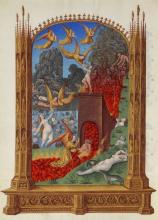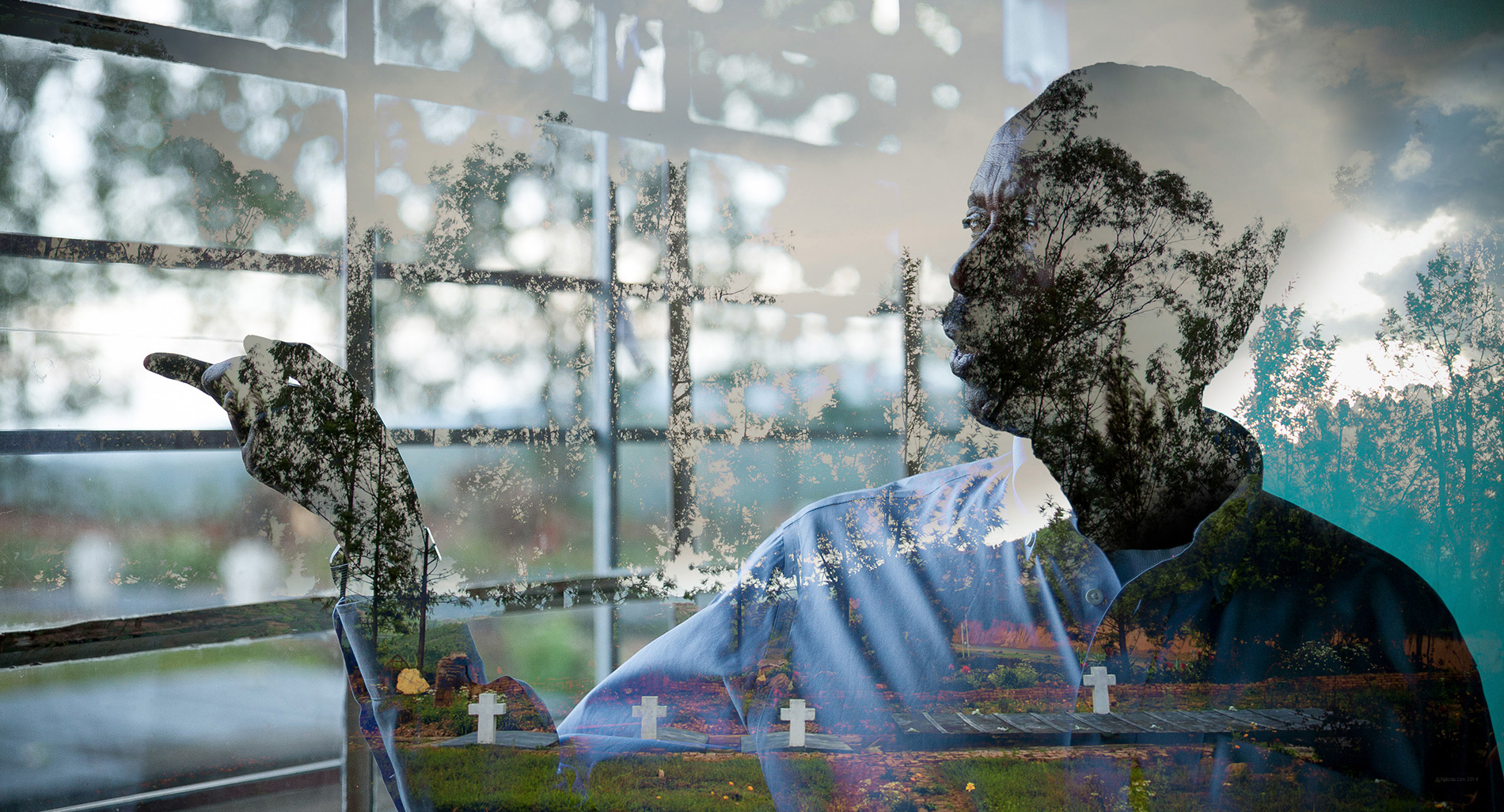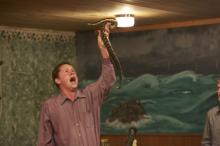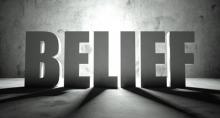Salvation

Since his critically acclaimed album, To Pimp a Butterfly, Kendrick Lamar has been wrestling with the devil. But on GNX, his surprise album released last Friday, Lamar stops wrestling and writes a reconciliation between Satan and God.

GROWING UP, I read tons of historical fiction and often imagined the lives and times of my ancestors. My curiosity stemmed, in no small part, from my family, who dragged us to every available Black history and Black art museum. Whether visiting California’s first and only Black town, where my great-great-grandparents had bought land; making a pilgrimage to the National Underground Railroad Freedom Center during a family reunion; taking Black history bus tours; or hearing family stories from my grandmother and great-aunt, Black history was never far from our everyday lives.
Recently, technological developments and my growing archival research skills have enabled me to dig further into our family history. As DNA ancestry testing and digitized documents have become more widespread, I have been able to find graves and documents that could have been lost to history. The past, for me, has become even more close at hand as a crucial way of understanding the present.
Relating to the past in this way—an approach that resonates with Black families across the diaspora—stands in stark contrast to ongoing efforts to erase, distort, and lie about history.

I’ve grown weary of even engaging such attacks on CRT, so lacking are they in intellectual and moral integrity. Never mind that CRT is primarily a legal theory of how U.S. law has and should address racial discrimination, not a program of salvation; never mind that Greenway’s reading of the BFM would prohibit Southern Baptists from voting, speaking at municipal town halls, or engaging in any civic duty that does not literally and explicitly involve evangelism; never mind that critical race theorists, such as Kimberlé Crenshaw and Robin D.G. Kelley, propose means for overcoming the very “division, guilt and blame” that is supposedly celebrated by CRT proponents. Efforts to convince those so clearly immune to facts are rarely successful.

“THEY WERE AFRAID.” Those are the last words of the earliest manuscripts of Mark’s gospel (16:8)—the oldest of the four gospels. Mark ends his story about Jesus with Mary Magdalene, Mary the mother of James, and Salome at the empty tomb. Terror seizes them. They flee in shocked silence. The end. What kind of Easter is this?
Scribes and theologians thought the same, so a couple centuries later they added different endings to Mark—easier endings, with Jesus coming back to offer further teachings. In Mark’s original Easter account, however, there is no resolution to the story. Instead, we read about three women at a tomb, bewildered. Here, resurrection doesn’t resolve anything. Instead, the event unsettles. The absence of a corpse provokes questions and invites a hope in the promise of unimaginable possibility. “Jesus is going ahead of you to Galilee,” a strange messenger in the empty tomb tells them, “there you will see him.”
Easter is an ending without a conclusion, a story without finality. The end returns us back to the beginning—to Galilee, where Jesus was born, where he was baptized, where he gathered disciples, where he healed the sick, fed the hungry, and preached good news. Resurrection means that nothing, not even death, will prevent Jesus’ invitation for us—who are weak and fearful, bewildered by a world we can’t control—to follow messengers who guide into the mysteries of Christ in the here and now.

“WE'RE CAPTURED by sin, we’re captive to a power,” said theologian Stanley Hauerwas, “not as something so much that I do as something that I’m captured by and that I don’t even recognize as captivity.”
In this month’s scriptures, we confront the captivity of sin—social forces that diminish life, powers of oppression that colonize our desires. Sin whispers lies about the world, deceptions that lead to harmful acts—harmful for our personal lives with neighbors and our collective lives as a society.
The gospel passages assigned for the first and last Sundays spotlight the sinful power of money—from the marketplace’s corruption of the temple courts to Judas Iscariot’s betrayal of Jesus in exchange for silver. Money bookends Lent. We cannot talk about Jesus without talking about how mammon worms itself into our longings—the allure of wealth, the power of profits.
Jesus enacts liberation from the sinfulness of the thrall of money. In John 2, Jesus frees people from money’s bondage by scattering gold and silver in the streets. He seizes the currency of the bankers. He redistributes the wealth of the few into the pockets of the many. The reign of God will involve an economic overhaul. Lent would be a fitting season to tax the rich and to cancel student and medical debt.

Hermits exist in many of the world’s major religious traditions: They are individuals who choose temporary or permanent solitude in remote and isolated locations, such as mountains, caves and deserts. These locations are frequently depicted as sites for revelation and transformation.

Salvation cannot remain an individualized spiritualized concept. When the psalmists called out for salvation, they meant salvation from present suffering and danger. When the crowd shouted “Hosanna” at Jesus’ arrival in Jerusalem, they weren’t referring to the afterlife. When we talk about salvation in the context of our warming climate, we mean deliverance from the most destructive force our species has ever faced. When it comes to climate change, we have to think about community and salvation in a global sense. We must start to recognize that our communities are mutually dependent upon each other.

“All flesh shall see the salvation of God” (Luke 3:1-6). Well, that depends.
It depends on where you are from. It depends on your country of origin. It depends on your religion. It depends on with whom you are associated. It depends on your race, your ethnicity, your gender, your sexual orientation. The list of criteria for salvation, contrived predominantly from our many fears, is long according to the world as we know it today, but not according to the Gospel of Luke. And since Luke is providing a particular portrait of Jesus, not according to Jesus either.
This passage from Luke for the Second Sunday of Advent points to competing worldviews. The opening verses are deceptively subversive. Into the religious reigns and imperial kingdoms of the first century C.E., the word of God comes. Emperor Tiberius, Pontius Pilate, Herod, Philip, Annas, and Caiaphas will have to tend with the rule of the word of God, a rule that insists on salvation for all.

This Nov. 2, on what is known as All Souls’ Day, Roman Catholics around the world will be praying for loved ones who have died and for all those who have passed from this life to the next. They will be joined by Jerry Walls.
“I got no problem praying for the dead,” Walls says without hesitation — which is unusual for a United Methodist who attends an Anglican church and teaches Christian philosophy at Houston Baptist University.
Most Protestant traditions forcefully rejected the “Romish doctrine” of purgatory after the Reformation nearly 500 years ago. The Protestant discomfort with purgatory hasn’t eased much since: You still can’t find the word in the Bible, critics say, and the idea that you can pray anyone who has died into paradise smacks of salvation by good works.
The dead are either in heaven or hell, they say. There’s no middle ground, and certainly nothing the living can do to change it.
Many Catholics don’t seem to take purgatory as seriously as they once did, either, viewing it as fodder for jokes or as the “anteroom of heaven,” an unpleasant way station that is only marginally more appealing than hell.
But Walls is a leading exponent of an effort to convince Protestants — and maybe a few Catholics — that purgatory is a teaching they can, and should, embrace. And he’s having a degree of success, even among some evangelicals, that hasn’t been seen in, well, centuries.

Do you have a favorite superhero? I’ve always liked Batman. As a boy, I read all the Batman comic books. I like the cape and the cowl, the bat logo, the cool car with the flames coming out the back, the interesting villains.
What I like especially is that Batman is a regular person. Other superheroes fly or run at supersonic speeds or stretch their body parts in ways that are very strange and make you wonder. Batman has none of those powers. He’s like us — well, regular except for the part about being ultra-rich and living in a mansion above a bat cave …
The bottom line is that Batman fights for a better world using the things available to all of us: Creativity. Commitment. Courage. A passion to make a difference someone else’s life.
He reminds me of the super hero in each of us.

Next to a glass casing displaying neatly stacked skulls, Rwamasirabo flipped through the pages of a dusty notebook holding the church’s paperwork. He pulled out a church program. On it, was a photo of his former friend, Father Athanase Seromba, a 31 year-old Roman Catholic priest who was responsible for killing 3,000 of his Tutsi congregation members. The priest wore a black oxford with a white clerical collar accessorized with a distrusting mustache and a toothy smile seething betrayal. Rwamasirabo stuffed the program back into the notebook.
Rwamasirabo’s thin stature commands respect and the lines in his face convey tragic sorrow. His careful, soft-spoken voice expressed feelings of loss. With worn hands, Rwamasirabo searched through a pile of salvaged rubbish to find the chalice from which communion was served.
It reminded him of his daughter.

Seven years ago this week, I had my “come to Jesus” moment.
That’s not to say that over the past few years I haven’t had many experiences in which I’ve come away wondering “did I ever really believe up until now?” Many of those moments were far more profound and life-changing. It’s just that for me, it’s where a certain chapter of my life began.
I was raised in a Christian tradition that prized altar calls and bowing your heads, closing your eyes, and raising your hands to be saved. There was a clear delineator of when you were “born again” and when you were not. It was a moment in history, not just a spiritual exercise.
I don’t totally disagree. I think that there is something significant about the moment you first say yes, the same way I can remember the first time my best friend and I stopped just being colleagues. Our friendship has had many more important moments, but going to see Alice in Wonderland after work on a rainy Monday evening in March was where it started.
But as I have persisted (persevered for you Calvinists) in this faith I’ve discovered more and more what a relationship with God is like. In order for it to work, as Martin Luther famously said, all of life must be repentance. Every day the choice to say “yes” and not “no, I’m so done with this” is just as significant, if not more because coming to Jesus is often easier than staying.

FOR GENERATIONS, Native North Americans and other Indigenous peoples have lived the false belief that a fulfilled relationship with their Creator through Jesus required rejecting their own culture and adopting another, European in origin. In consequence, conventional approaches to mission with Indigenous peoples in North America and around the world have produced relatively dismal outcomes.
The result has subjected Indigenous people to deep-rooted self-doubt at best, self-hatred at worst.
One of the more egregious examples of the “conventional” approach in Canada involved the church-run residential schools. Indigenous children were taken from their families, prevented from speaking their native languages, and subjected to various other forms of abuse.
Isabelle Knockwood, a survivor of church-run residential schools, observed, “I thought about how many of my former schoolmates, like Leona, Hilda, and Maimie, had died premature deaths. I wondered how many were still alive and how they were doing, how well they were coping, and if they were still carrying the burden of the past on their shoulders like I was.”
Given the countless mission efforts over the past four centuries (which in practice were targeted not so much to spiritual transformation as to social and cultural annihilation), we might conclude that Indigenous people must possess a unique spiritual intransigence to the gospel.

One sort of Christian believes taking Eucharist weekly saves her. Another Christian believes his confession of Jesus Christ as Lord saves him. Still another looks to his Baptism. Another to her participation in the body of Christ. One to his repentance. And another to her care for the sick, the hungry, the prisoner, and the poor.
We elevate one belief or practice over another, then divide ourselves as Christ followers by the priority we set when, in fact, all of these are taught as saving by Christ, who alone is our salvation.
Christ saves me, not the accuracy and purity of my beliefs. Christ saves me, not my works. Christ saves me, not the measure of my adherence to a doctrine or practice.
When all is said and done, many Christians tend to look to their habits, their faith, and their perseverance when it comes to salvation rather than to the work, belief, and faithfulness of Christ in us, over us, under us, and through us.

There is an old Christian hymn that has the lyrics "They'll know we are Christians by our love." It was written in the late 60s and was inspired by the Bible verse John 13:35, where Jesus says, "By this everyone will know that you are my disciples, if you love one another." (NIV)
Really? We're supposed to be able to tell the difference between Christians and non-Christians? And the difference is love?!
In reality, it's not nearly that simple, and the fact is, there’s no visible difference.
If you were to go to the grocery store, a football game, the gym, a school, or your work, there would be no obvious way of identifying — through actions — who is a Christian and who isn't, and we should be careful not to judge.
Some of the kindest, nicest, authentic, and wonderful people I know don't believe in Jesus. Contrarily, there are some horrible, mean, and downright disgusting Christians.

Pope Francis’ friendly letter to atheists, published this week by Italy’s La Repubblica newspaper, has been cheered by Catholics who welcomed another sign of the pontiff’s new openness to the world beyond the Vatican walls.
But it has also prompted some gnashing of teeth among others, who are reacting to headlines about the pope’s letter like this one in the British newspaper The Independent:
“Pope Francis assures atheists: You don’t have to believe in God to go to heaven.”

If there were such a thing as “spiritual hazard pay” for columnists, I would be filing a claim after watching the first two episodes of the new series “Snake Salvation,” which debuts Tuesday, Sept. 10, on the National Geographic Channel.
God, I hate snakes. I find them utterly repellent; always have. When I was a toddler, my parents had to carry me out of the snake house at the zoo so I would stop screaming as if someone were trying to kill me.
Were it not for professional obligation — you’re welcome, by the way — you would sooner have found me shaving my head with a straight razor than watching a couple of hours of television dedicated to snake handling and its (alleged) spiritual import.

UNTIL RECENTLY, a company in New York City offered “a ride through a real New York City ‘ghetto’”—a $45 bus tour of the Bronx, reportedly patronized mainly by European and Australian tourists. One news report described the tour guide sharing lurid stories of crime and arson from the ’70s and ’80s, making insensitive comments about everything from local architectural landmarks to people waiting in line at a food pantry, and warning about the “pickpockets” in wait in a certain park. After an outcry from residents and officials, angry that the place they call home would be reduced to out-of-touch stereotypes, the tour company shut down in May.
That someone would even think of fleecing misguided tourists this way hints at the complicated, sometimes contradictory, role that cities play in our culture: In our collective imagination they represent both civilization’s pinnacle (arts, style, technology, intellectualism, innovation, industry, finance) and depravity’s depths (crime, corruption, exploitation, decadence, filth). For much of the 20th century, many people of means fled cities for the pastoral promise of the suburbs, while many a farm girl or boy dreamed of escaping to a city and tasting the bustle and thrill: “Until I saw your city lights, honey I was blind.”
And yet cities are not only symbols, but real and intricate places. Whether booming or busting, they shape and are shaped by the people in them. Both the built structures and the people of a city have stories to tell. But a fleeting tour-bus view with distorted narration can lead us down an alley with no exit.
Here are some different takes on the bright lights of the big city.

There are lots of biases and assumptions about Christians out there, many of which are founded in real-life experience. And yes, we Christians have done our share of damage when it comes to tarnishing our so-called “brand.” But there also seems to be this tendency to understand Christianity and its adherents as one generally monolithic group that can be described in simple (often negative) terms that they would never be acceptable to apply to any other group.
Part of this is because of the historic dominance of the Christian culture in the modern Western world. It’s the same reason that stereotypes of men on network sitcoms are pervasively unflattering, while the same stereotypes would cause a firestorm of negative publicity if applied to the female counterparts. Some of this is entirely warranted and necessary in tearing down false or damaging constructs of power. But sometimes, if we’re being honest, they’re just wrong. And stupid.

During the Christian spiritual journey, followers of Christ are forced to eventually face some basic faith-related questions. Here are a few of the most common ones:
1) What is salvation?
What does salvation really mean? When does it happen and is it permanent? Do you choose your own salvation or is it predestined? Is everyone saved or just a select few?
The idea of salvation is extremely complex, and our concept of it directly influences how we live, evangelize, and interact with the people around us.